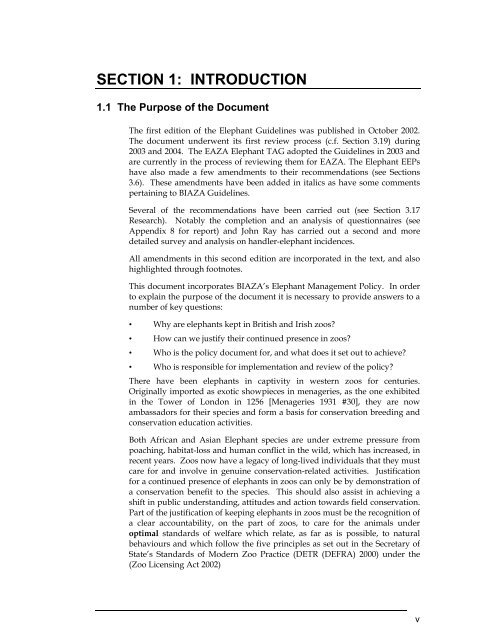Elephants Elephants - Wildpro - Twycross Zoo
Elephants Elephants - Wildpro - Twycross Zoo
Elephants Elephants - Wildpro - Twycross Zoo
Create successful ePaper yourself
Turn your PDF publications into a flip-book with our unique Google optimized e-Paper software.
SECTION 1: INTRODUCTION<br />
1.1 The Purpose of the Document<br />
The first edition of the Elephant Guidelines was published in October 2002.<br />
The document underwent its first review process (c.f. Section 3.19) during<br />
2003 and 2004. The EAZA Elephant TAG adopted the Guidelines in 2003 and<br />
are currently in the process of reviewing them for EAZA. The Elephant EEPs<br />
have also made a few amendments to their recommendations (see Sections<br />
3.6). These amendments have been added in italics as have some comments<br />
pertaining to BIAZA Guidelines.<br />
Several of the recommendations have been carried out (see Section 3.17<br />
Research). Notably the completion and an analysis of questionnaires (see<br />
Appendix 8 for report) and John Ray has carried out a second and more<br />
detailed survey and analysis on handler-elephant incidences.<br />
All amendments in this second edition are incorporated in the text, and also<br />
highlighted through footnotes.<br />
This document incorporates BIAZA’s Elephant Management Policy. In order<br />
to explain the purpose of the document it is necessary to provide answers to a<br />
number of key questions:<br />
• Why are elephants kept in British and Irish zoos?<br />
• How can we justify their continued presence in zoos?<br />
• Who is the policy document for, and what does it set out to achieve?<br />
• Who is responsible for implementation and review of the policy?<br />
There have been elephants in captivity in western zoos for centuries.<br />
Originally imported as exotic showpieces in menageries, as the one exhibited<br />
in the Tower of London in 1256 [Menageries 1931 #30], they are now<br />
ambassadors for their species and form a basis for conservation breeding and<br />
conservation education activities.<br />
Both African and Asian Elephant species are under extreme pressure from<br />
poaching, habitat-loss and human conflict in the wild, which has increased, in<br />
recent years. <strong>Zoo</strong>s now have a legacy of long-lived individuals that they must<br />
care for and involve in genuine conservation-related activities. Justification<br />
for a continued presence of elephants in zoos can only be by demonstration of<br />
a conservation benefit to the species. This should also assist in achieving a<br />
shift in public understanding, attitudes and action towards field conservation.<br />
Part of the justification of keeping elephants in zoos must be the recognition of<br />
a clear accountability, on the part of zoos, to care for the animals under<br />
optimal standards of welfare which relate, as far as is possible, to natural<br />
behaviours and which follow the five principles as set out in the Secretary of<br />
State’s Standards of Modern <strong>Zoo</strong> Practice (DETR (DEFRA) 2000) under the<br />
(<strong>Zoo</strong> Licensing Act 2002)<br />
v

















